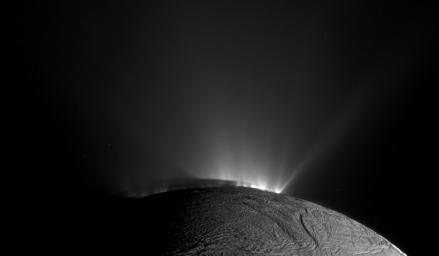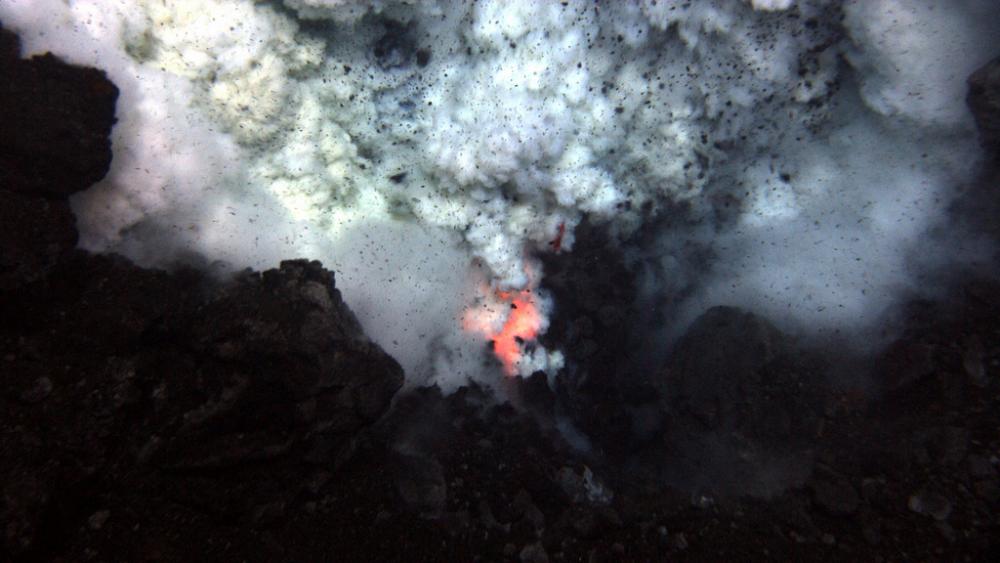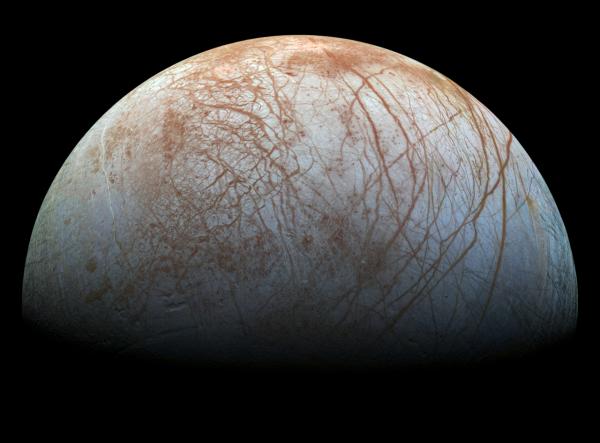Over tens of millions of years, the surface of Europa has been churned by impacts down to an average depth of 30 centimeters. This churning means that the search for chemical biosignatures must look below that zone. Plus, methane and icequakes at Enceladus, predicting underwater eruptions, Virgin Galactic’s flight, and a Chinese spacewalk.
Podcast
Transcript
Hello and welcome to the Daily Space. I am your host Dr. Pamela Gay.
And I am your host Beth Johnson.
And we are here to put science in your brain.
Our first story sounds a little similar to one we covered last year, up to and including the media hype. Phosphine on Venus! Signs of life! Only this time, the gas is methane and the planet is a moon – Saturn’s moon Enceladus, to be specific.

In new work published in Nature Astronomy, researchers used mathematical models to try to understand the reason for the large amount of methane found in the plumes of Enceladus by the Cassini spacecraft. These models combined geochemistry and microbial ecology, looking at the amounts of dihydrogen, methane, and carbon dioxide in the plumes. As co-author Regis Ferriere explained: We wanted to know: Could Earthlike microbes that ‘eat’ the dihydrogen and produce methane explain the surprisingly large amount of methane detected by Cassini? Searching for such microbes, known as methanogens, at Enceladus’ seafloor would require extremely challenging deep-dive missions that are not in sight for several decades.
The team tested a variety of different models to assess just how much methane could be produced depending on the conditions, including hydrothermal production of dihydrogen, possible population dynamics, and temperature. The results don’t say there is life. What they do say is that the amount of methane could be explained by biological processes but more data is required to know for certain. Basically, it could be life, but to find out if it is life, well, we need to go there and get a sample.
As the search for life elsewhere in our solar system ramps up, the tidal forces from Saturn and its larger moons that act on Enceladus may make those oceans warm enough to sustain life deep below the surface. These tidal forces heat up the interior of Enceladus, similar to how Jupiter and its moons make Io hot enough to have surface volcanism.

Now, new research in JGR: Planets has examined just how the tidal forces affect the surface ice of Enceladus, cracking it and even causing the geysers of water we have captured images of, especially at the so-called tiger stripes. The scientists involved used the Earth analog of the Ross Ice Shelf in Antarctica to see how seismic activity would affect the surface ice, and they found features that were similar to those seen on Enceladus.
Unlike larger earthquakes, the icequakes in Antarctica seem to be continuous, like a set of “little pops and fractures”, that particularly occurred around rifts on the ice slab. By understanding the icequakes here on Earth, we might be able to determine just how thick the surface ice is on Enceladus, and then we can figure out if that thickness is enough to protect any potential underwater life from the radiation that hits the moon. There are no missions to Enceladus planned currently, but I think this icy moon is a great target for one.
Understanding how a moon or planet works below the surface or deep in its oceans isn’t just for icy moons. We are still trying to understand how Earth works! Unlike how scientists tracked the magma flow under Iceland using seismic data, basically predicting the ongoing eruption we are all still enjoying on YouTube, it’s very difficult to get seismic monitors to the ocean floor. It’s not impossible. But the ocean is vast and deep, making the placement of instruments expensive and time-consuming. So one scientist looked for another method to add to the toolbox, something we can use that is already in place. In this case, satellite imagery.

In a new study in the journal Water, Yuji Sakuno has suggested using satellite images of sea discoloration as a new predictor of an impending underwater volcanic eruption. Volcanoes release different chemicals as they erupt, as part of the gas and minerals trapped in the magma. These chemicals can then change the color of the water. For example, iron can turn the water more yellow or brown; aluminum creates white splotches in the water. Sakuno examined images captured in 2020 around an island in Japan that erupted and was able to find changes in the seawater that occurred a month before the eruption started.
This is just one volcanic eruption and one data set, but that means we can test the experiment with other eruptions and other satellite images, and maybe we have found a new, better predictor of underwater volcanic eruptions.
It finally happened: Virgin Galactic took civilians to the edge of space. On Sunday, July 11, pilots Dave Mackay and Michael Masucci flew Unity 22 to the edge of space with colleagues Richard Branson, Sirisha Bendla, Colin Bennett, and Beth Moses. With this flight, we entered a new domain of space tourism, where anyone with only an extra few hundred thousand can take a vacation that includes suborbital flight.
While this news may seem like it’s only exciting for the super-rich and their personally chosen guests, there may be some positive benefits to normal folks wanting to do science. These tourism rockets will increase access to suborbital opportunities for research and technology development. NASA’s Flight Opportunities program allows NASA and other researchers to get zero g/vacuum time either through parabolic flights in a plane, high altitude flights in a balloon, or suborbital flights in either a sounding rocket or commercial tourism vehicle.

A plane flying parabolas can provide over twelve minutes of weightlessness for a payload, which is more than a suborbital rocket, but in 30-second bursts followed by double gravity. Planes are therefore used for medical experiments, robotic systems, and space manufacturing.
Stratospheric balloons don’t allow for any microgravity research but do allow payloads to spend weeks in the upper atmosphere which is useful for some payloads such as solar observation, earth observation, or drop tests such as the Low-Density Supersonic Decelerator (LDSD) which tested new heat shield technology for future Mars missions.
Commercial tourism rockets allow new capabilities for science. New Shepard can carry up to 100.5 kilograms of payloads for three minutes of pure microgravity. Payloads can be mounted both inside the pressurized crew capsule and outside on the booster. These different payload capabilities permit not just zero-g research but also rocket guidance demonstrations such as the Navigation Doppler LIDAR, which will be used to help “precision soft landings on the Moon and Mars”. That payload flew on a New Shepard booster in October 2020.
The other major space tourism vehicle, Virgin Galactic’s SpaceShipTwo, is also registered in the Flight Opportunities program. SpaceShipTwo can carry 450 kilograms of payload for the same three minutes of weightlessness as New Shepard, despite going to a slightly lower apogee of 80 kilometers. A NASA Flight Opportunities payload that has flown on New Shepard is the COLLisions Into Dust Experiment (COLLIDE) which we’ve previously talked about here on Daily Space.
Besides increased payload mass and microgravity time, suborbital tourist rockets also allow quicker access to science payloads after landing. SpaceShipTwo is the easiest since it returns right to a runway. Scientists can get immediate access to their payloads for analysis. New Shepard also allows for quick access since it doesn’t land far away from the launch site and payloads (passengers) are supposed to be extracted quickly. Combined with the increased microgravity time this makes them better options compared to a zero-g plane or a sounding rocket, which also lands on a runway but provides shorter microgravity time and has payloads that are not always designed to be recovered after launch.
In addition to NASA and university researchers, the new tourist rockets allow school students to fly payloads into space. One such payload is on Blue Origin’s New Shepard. Teachers In Space, Inc. provides kits of 1 to 3 Unit 3D printed CubeSat chassis, about the size of a loaf of bread (10x10x30cm). Teachers In Space calls this a Cube Frame, and it comes with all the necessary electronics to support a payload that the students make. All of the electronics are based on the Arduino microcontroller system. The first flight of a Cube Frame payload was May 2019. Teachers In Space offers the kits and a curriculum with different phases. Teachers can pick which parts they wish to use or buy a complete package including a flight on either a balloon, jet, or suborbital rocket.
These rockets will also allow more human researchers to make regular suborbital flights, not just payloads, though no plans have been announced either by NASA, Virgin Galactic, or Blue Origin. However, Mission Specialist Sirisha Bandla did perform a crew-tended experiment on this past weekend’s Unity 22 flight of SpaceShipTwo which involved her activating preservatives in special tubes full of plants at key times before, during, and after microgravity.
And now, back to icy moons. While Enceladus is on the radar for possible life, as we mentioned earlier, there are currently no missions planned to go to the tiny world. However, another icy moon, larger and just as interesting, Europa, is on the mission schedule with the Europa Clipper.

New research published in Nature Astronomy examines the results of “impact gardening” on the surface of Europa. For tens of millions of years, small impacts have churned the icy surface down to an average depth of 30 centimeters. That surface is scarred and battered, covered in tiny craters that fracture the ice. As with Enceladus, one of the issues with habitability is the radiation that hits the surface. Under the ice, life would be protected. But if that ice is being churned, some of the subsurface water could be brought to the surface, and evidence of life might be destroyed by the radiation. Some of that surface ice could also get moved into the water, mixing into the ocean and changing the chemical composition, possibly affecting any life.
Lead author Emily Costello notes: If we hope to find pristine, chemical biosignatures, we will have to look below the zone where impacts have been gardening. Chemical biosignatures in areas shallower than that zone may have been exposed to destructive radiation.
This work constitutes the first time scientists have examined impact gardening in relation to Europa’s surface and the impacts experienced by outer solar system bodies. Co-author Cynthia Phillips from JPL notes: This work broadens our understanding of the fundamental processes on surfaces across the solar system. If we want to understand the physical characteristics and how planets in general evolve, we need to understand the role impact gardening has in reshaping them.
Additionally, the research done here could assist with the design of the upcoming Europa Clipper mission, providing guidance for instrumentation and biologic missions. And co-author Rebecca Ghent from the Planetary Science Institute points out: …it also provides a framework for future investigation using higher-resolution images from upcoming missions, which would help to generate more precise estimates on the depth of gardening in various specific regions.
Anything that gets us closer to finding out definitively if there is life in the oceans of Europa or even Enceladus is worth its weight in published paper, in my opinion. We’ll be interviewing Dr. Emily Costello on a future episode, so make sure you’re following us on Twitter for the announcement of that date.
If it seems like we have a strange amount of content that might normally end up in Rocket Roundup today, it’s because we do. There has been so much going on that it just had to spill over into a Tuesday.
At 00:11 UTC on July 4, 2021, two Chinese astronauts conducted the country’s second-ever spacewalk, this one from their new Tianhe core module. With it, China joins the United States and Russia as countries that have done EVAs from their own space stations.

The total duration of the spacewalk was nearly seven hours, far more than the first Chinese EVA on Shenzhou 7 back in 2008 which lasted twenty minutes. Despite the extended duration of the EVA, Chinese media didn’t say much about what the two astronauts, Liu Boming and Tang Hongbo, did while outside.
What is known is they attached an EVA foot restraint to the station’s robotic arm. They then used that arm to get in the right position to install a panoramic camera which had been folded against the module since launch. Taikonaut Nie Haisheng operated the robotic arm from a console inside the station. This method of close cooperation between spacewalkers and arm operators will be key for future station expansion and maintenance. This will be important as there will be at least two more modules added to the station in 2022 and 2023 respectively.
To further add to its usefulness, the robotic arm can be controlled remotely from the ground. After being carried around on the robotic arm unfolding the camera, Tang Hongbo successfully performed an emergency airlock return drill where he had to get back to the hatch as quickly as possible as if there was a problem with his suit. This was necessary training to practice in the event of an emergency on a future EVA.
Luckily this EVA went without any major issues, and both crew members successfully returned back into Tianhe at the conclusion of their spacewalk. The preparations for and a portion of the spacewalk itself were carried on the Chinese state TV network CGTN on a time delay in typical Chinese fashion.
The EVA also demonstrated newly designed spacesuits which were derived from the Orlan-MKS, the most recent Russian spacesuit. Compared to the U.S. EMU spacesuit, the Feitian and Orlanspacesuits are a single piece that the astronauts put on by climbing through the hinged back of the suit. The EMU is more complicated: it has separate legs and torso segments that require another astronaut’s assistance to put on. This makes it better in some respects though, as it has more flexible joints and individual parts can be changed to better suit different astronauts’ body sizes. Orlan is “one size fits most”. Both suits use about the same operating pressure, 4.3 PSI for the EMU and 5.8 PSI for the Orlan.
One suit had red stripes and the other blue to tell the different spacewalkers apart, just like the U.S. and Russian suits. The Feitian suit is capable of providing life support for seven hours, compared to the four hours of the first Chinese spacesuit that was derived from an older version of the Orlan. Additionally, the ergonomics and materials of the new spacesuit have improved, resulting in the wearer needing to expend less energy fighting against the suit to get their tasks done, compared to the old suit. Specifically, the glove was changed to make it easier to grasp things such as the safety tether hook; pretty important if you don’t want to float off into space. It’s also more comfortable to wear for extended periods, according to Taikonaut Liu in a pre-launch interview. He also participated in the first Chinese spacewalk on Shenzhou 7. On that spacewalk, he wore an actual Russian Orlan-M spacesuit.
This has been the Daily Space.
Want more of us? Check out CosmoQuest.org and get tickets for CosmoQuest-a-Con, our 80s space party that will take place July 16-18.
Learn More
High Amounts of Methane Found at Enceladus
- University of Arizona press release
- Methane mystery on Saturn’s icy moon Enceladus: Could it be a sign of life? (CNET)
- “Bayesian analysis of Enceladus’s plume data to assess methanogenesis,” Antonin Affholder et al., 2021 June 7, Nature Astronomy
Tidal Forces Cause Icequakes on Enceladus
- AGU press release
- “Projected Seismic Activity at the Tiger Stripe Fractures on Enceladus, Saturn, From an Analog Study of Tidally Modulated Icequakes Within the Ross Ice Shelf, Antarctica,” Kira G. Olsen et al., 2021 May 21, JGR Planets
Satellite Images May Help Predict Underwater Eruptions
- Hiroshima University press release
- “Trial of Chemical Composition Estimation Related to Submarine Volcano Activity Using Discolored Seawater Color Data Obtained from GCOM-C SGLI. A Case Study of Nishinoshima Island, Japan, in 2020,” Yuji Sakuno, 2021 April 16, Water
Virgin Galactic’s Unity 22 Takes Flight
- Virgin Galactic press release
- NASA and Blue Origin Help Classrooms and Researchers Reach Space (NASA)
- NASA Tipping Point Partnership with Blue Origin to Test Precision Lunar Landing Technologies (NASA)
- NASA-Supported Plant Experiment Flies to Suborbital Space with Virgin Galactic (NASA)
Impacts Churn the Surface of Europa
- University of Hawai’i Mānoa press release
- NASA JPL press release
- PSI press release
- “Impact gardening on Europa and repercussions for possible biosignatures,” E. S. Costello, C. B. Phillips, P. G. Lucey & R. R. Ghent, 2021 July 12, Nature Astronomy
Chinese Astronauts Conduct Spacewalk
- CMS press release (Chinese)
- CASC press release (Chinese)
- Chinese astronauts make first spacewalk outside new station (AP)
- Shenzhou 7 (Astronautix)
- Learn About Spacesuits (NASA)
Credits
Written by Pamela Gay, Beth Johnson, and Erik Madaus
Hosted by Pamela Gay and Beth Johnson
Audio and Video Editing by Ally Pelphrey
Content Editing by Beth Johnson
Intro and Outro music by Kevin MacLeod, https://incompetech.com/music/



 We record most shows live, on Twitch. Follow us today to get alerts when we go live.
We record most shows live, on Twitch. Follow us today to get alerts when we go live.